Enterprise Resource Planning Systems: Success Factors
VerifiedAdded on 2020/03/16
|14
|3704
|1246
AI Summary
This assignment delves into the topic of Enterprise Resource Planning (ERP) systems, focusing on the crucial factors contributing to their successful implementation. It draws upon various research papers and articles to analyze the complexities involved in ERP adoption, including organizational fit, management control, and user adoption. The assignment aims to provide a comprehensive understanding of the key considerations that organizations must address when implementing ERP systems to maximize their chances of success.
Contribute Materials
Your contribution can guide someone’s learning journey. Share your
documents today.
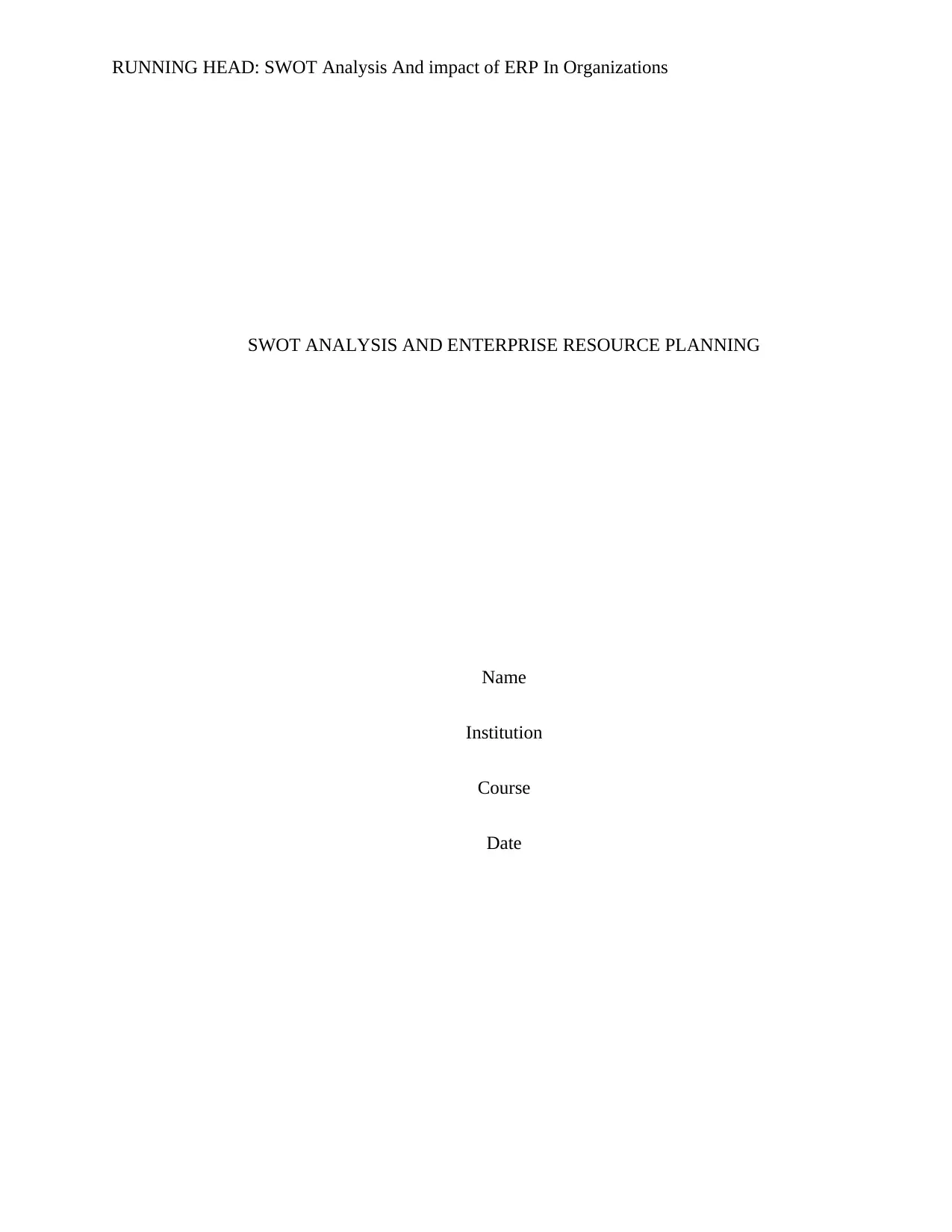
RUNNING HEAD: SWOT Analysis And impact of ERP In Organizations
SWOT ANALYSIS AND ENTERPRISE RESOURCE PLANNING
Name
Institution
Course
Date
SWOT ANALYSIS AND ENTERPRISE RESOURCE PLANNING
Name
Institution
Course
Date
Secure Best Marks with AI Grader
Need help grading? Try our AI Grader for instant feedback on your assignments.
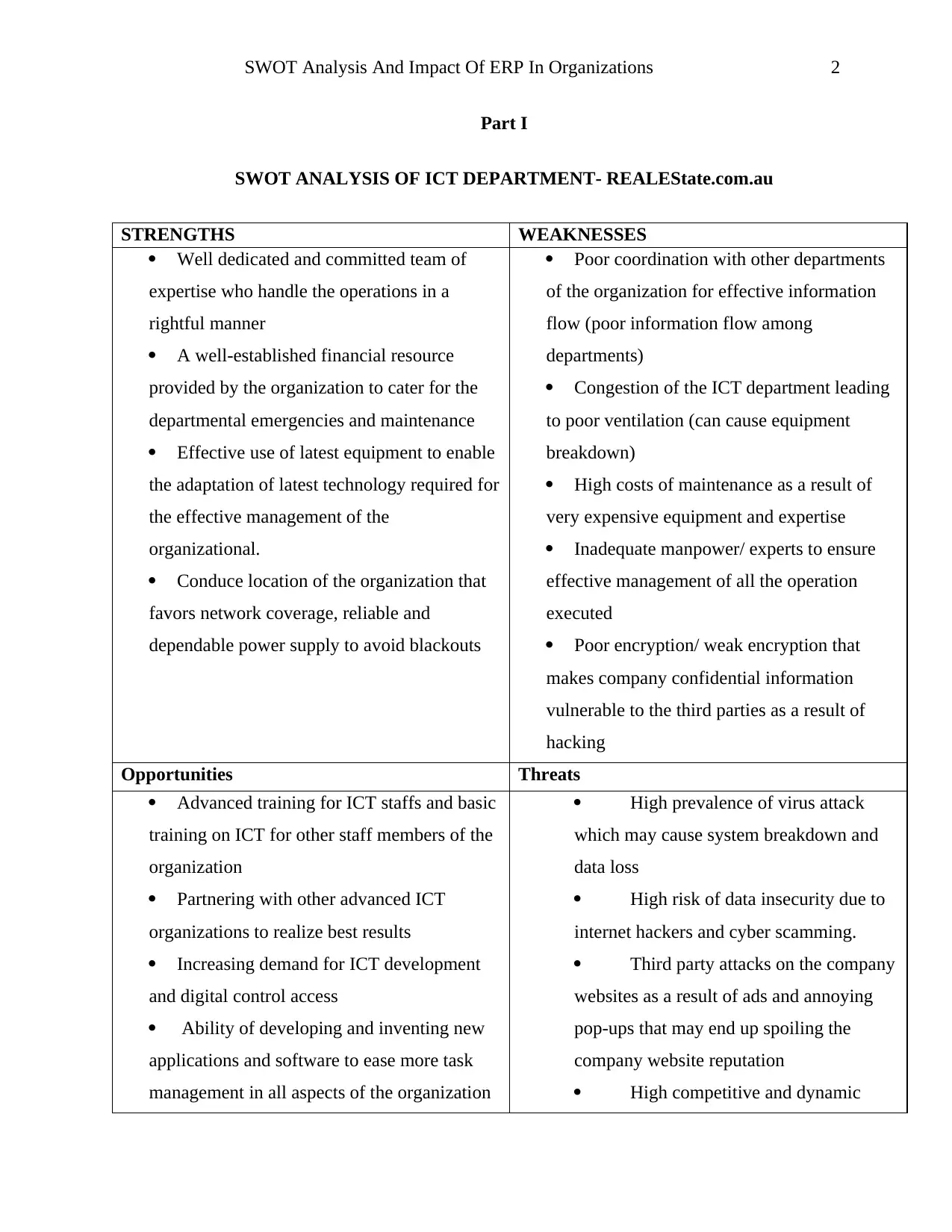
SWOT Analysis And Impact Of ERP In Organizations 2
Part I
SWOT ANALYSIS OF ICT DEPARTMENT- REALEState.com.au
STRENGTHS WEAKNESSES
Well dedicated and committed team of
expertise who handle the operations in a
rightful manner
A well-established financial resource
provided by the organization to cater for the
departmental emergencies and maintenance
Effective use of latest equipment to enable
the adaptation of latest technology required for
the effective management of the
organizational.
Conduce location of the organization that
favors network coverage, reliable and
dependable power supply to avoid blackouts
Poor coordination with other departments
of the organization for effective information
flow (poor information flow among
departments)
Congestion of the ICT department leading
to poor ventilation (can cause equipment
breakdown)
High costs of maintenance as a result of
very expensive equipment and expertise
Inadequate manpower/ experts to ensure
effective management of all the operation
executed
Poor encryption/ weak encryption that
makes company confidential information
vulnerable to the third parties as a result of
hacking
Opportunities Threats
Advanced training for ICT staffs and basic
training on ICT for other staff members of the
organization
Partnering with other advanced ICT
organizations to realize best results
Increasing demand for ICT development
and digital control access
Ability of developing and inventing new
applications and software to ease more task
management in all aspects of the organization
High prevalence of virus attack
which may cause system breakdown and
data loss
High risk of data insecurity due to
internet hackers and cyber scamming.
Third party attacks on the company
websites as a result of ads and annoying
pop-ups that may end up spoiling the
company website reputation
High competitive and dynamic
Part I
SWOT ANALYSIS OF ICT DEPARTMENT- REALEState.com.au
STRENGTHS WEAKNESSES
Well dedicated and committed team of
expertise who handle the operations in a
rightful manner
A well-established financial resource
provided by the organization to cater for the
departmental emergencies and maintenance
Effective use of latest equipment to enable
the adaptation of latest technology required for
the effective management of the
organizational.
Conduce location of the organization that
favors network coverage, reliable and
dependable power supply to avoid blackouts
Poor coordination with other departments
of the organization for effective information
flow (poor information flow among
departments)
Congestion of the ICT department leading
to poor ventilation (can cause equipment
breakdown)
High costs of maintenance as a result of
very expensive equipment and expertise
Inadequate manpower/ experts to ensure
effective management of all the operation
executed
Poor encryption/ weak encryption that
makes company confidential information
vulnerable to the third parties as a result of
hacking
Opportunities Threats
Advanced training for ICT staffs and basic
training on ICT for other staff members of the
organization
Partnering with other advanced ICT
organizations to realize best results
Increasing demand for ICT development
and digital control access
Ability of developing and inventing new
applications and software to ease more task
management in all aspects of the organization
High prevalence of virus attack
which may cause system breakdown and
data loss
High risk of data insecurity due to
internet hackers and cyber scamming.
Third party attacks on the company
websites as a result of ads and annoying
pop-ups that may end up spoiling the
company website reputation
High competitive and dynamic
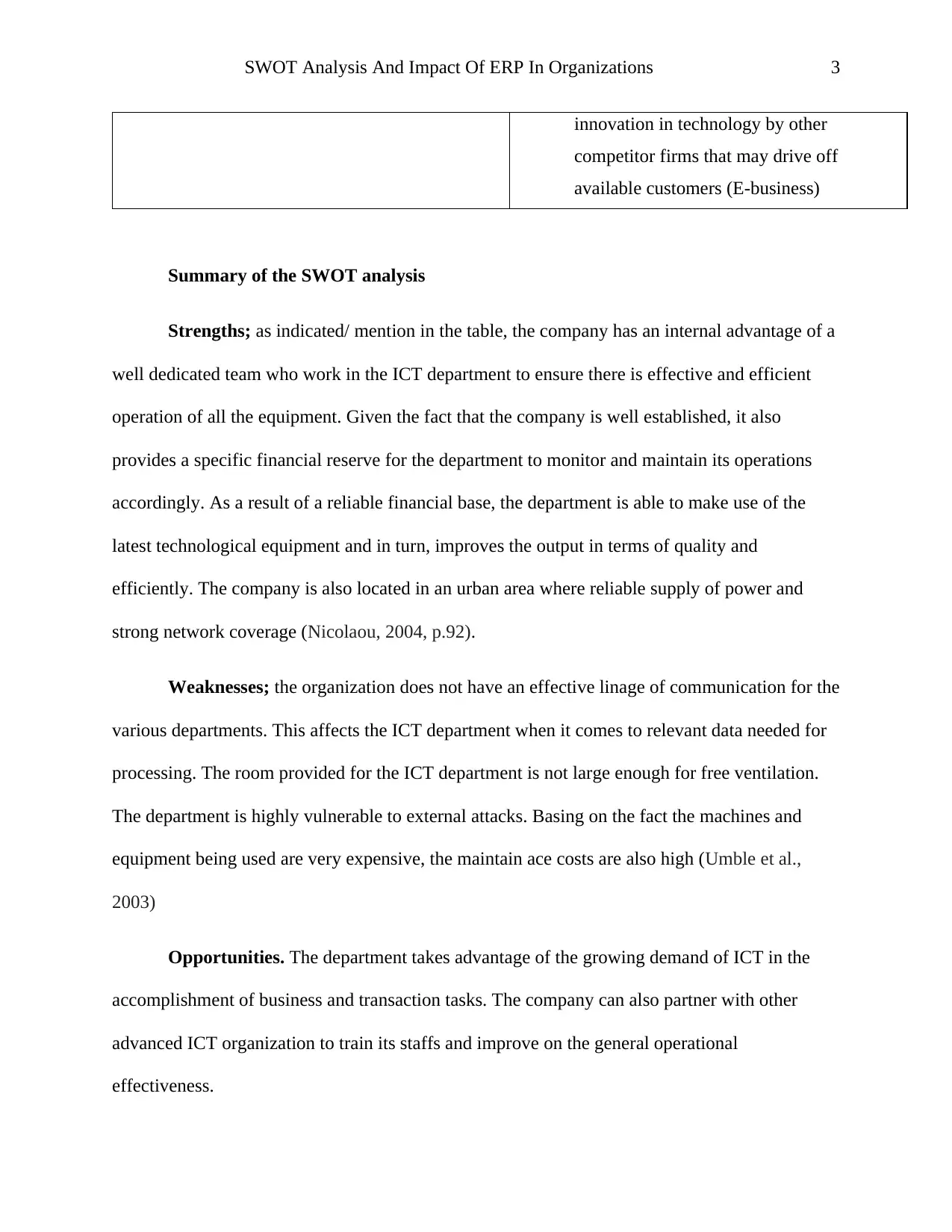
SWOT Analysis And Impact Of ERP In Organizations 3
innovation in technology by other
competitor firms that may drive off
available customers (E-business)
Summary of the SWOT analysis
Strengths; as indicated/ mention in the table, the company has an internal advantage of a
well dedicated team who work in the ICT department to ensure there is effective and efficient
operation of all the equipment. Given the fact that the company is well established, it also
provides a specific financial reserve for the department to monitor and maintain its operations
accordingly. As a result of a reliable financial base, the department is able to make use of the
latest technological equipment and in turn, improves the output in terms of quality and
efficiently. The company is also located in an urban area where reliable supply of power and
strong network coverage (Nicolaou, 2004, p.92).
Weaknesses; the organization does not have an effective linage of communication for the
various departments. This affects the ICT department when it comes to relevant data needed for
processing. The room provided for the ICT department is not large enough for free ventilation.
The department is highly vulnerable to external attacks. Basing on the fact the machines and
equipment being used are very expensive, the maintain ace costs are also high (Umble et al.,
2003)
Opportunities. The department takes advantage of the growing demand of ICT in the
accomplishment of business and transaction tasks. The company can also partner with other
advanced ICT organization to train its staffs and improve on the general operational
effectiveness.
innovation in technology by other
competitor firms that may drive off
available customers (E-business)
Summary of the SWOT analysis
Strengths; as indicated/ mention in the table, the company has an internal advantage of a
well dedicated team who work in the ICT department to ensure there is effective and efficient
operation of all the equipment. Given the fact that the company is well established, it also
provides a specific financial reserve for the department to monitor and maintain its operations
accordingly. As a result of a reliable financial base, the department is able to make use of the
latest technological equipment and in turn, improves the output in terms of quality and
efficiently. The company is also located in an urban area where reliable supply of power and
strong network coverage (Nicolaou, 2004, p.92).
Weaknesses; the organization does not have an effective linage of communication for the
various departments. This affects the ICT department when it comes to relevant data needed for
processing. The room provided for the ICT department is not large enough for free ventilation.
The department is highly vulnerable to external attacks. Basing on the fact the machines and
equipment being used are very expensive, the maintain ace costs are also high (Umble et al.,
2003)
Opportunities. The department takes advantage of the growing demand of ICT in the
accomplishment of business and transaction tasks. The company can also partner with other
advanced ICT organization to train its staffs and improve on the general operational
effectiveness.
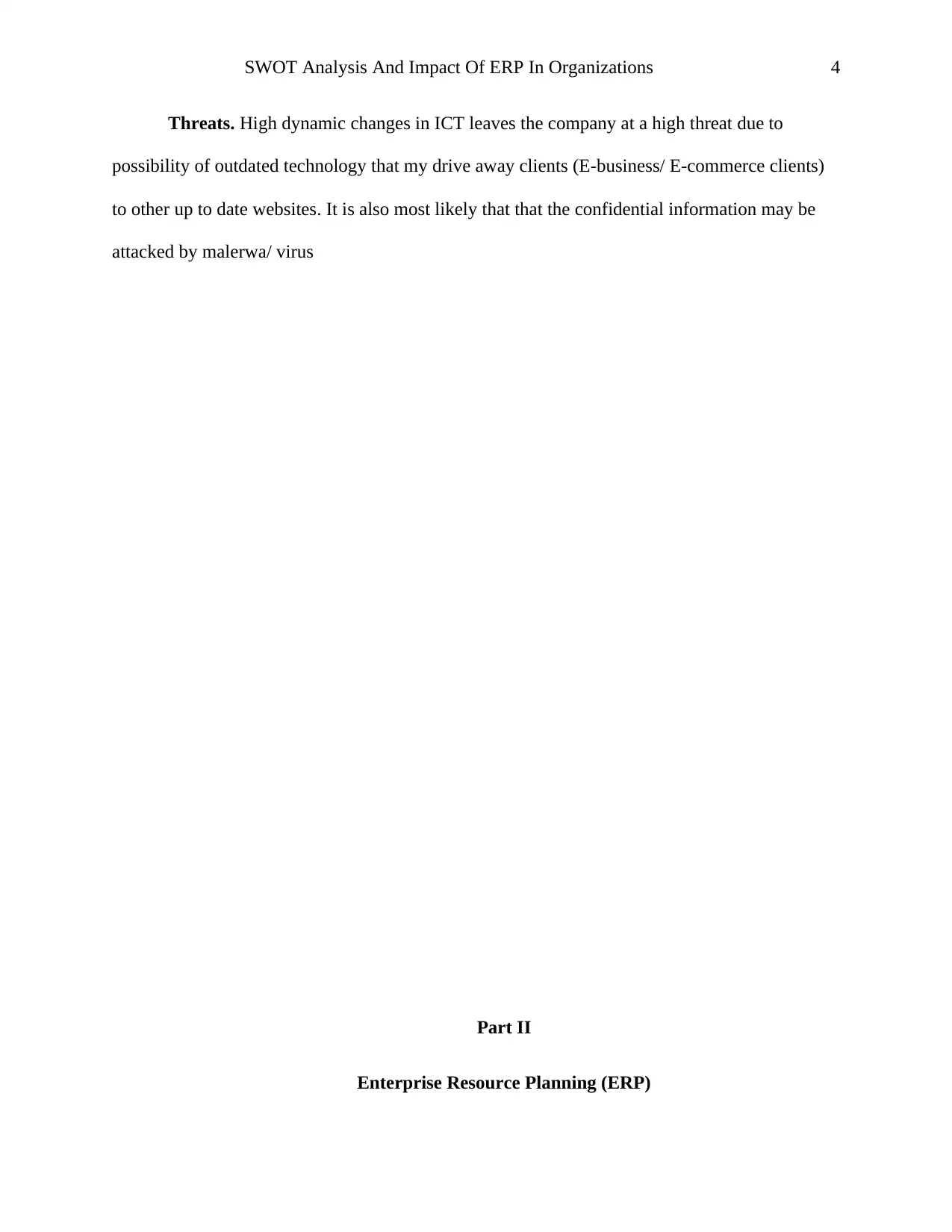
SWOT Analysis And Impact Of ERP In Organizations 4
Threats. High dynamic changes in ICT leaves the company at a high threat due to
possibility of outdated technology that my drive away clients (E-business/ E-commerce clients)
to other up to date websites. It is also most likely that that the confidential information may be
attacked by malerwa/ virus
Part II
Enterprise Resource Planning (ERP)
Threats. High dynamic changes in ICT leaves the company at a high threat due to
possibility of outdated technology that my drive away clients (E-business/ E-commerce clients)
to other up to date websites. It is also most likely that that the confidential information may be
attacked by malerwa/ virus
Part II
Enterprise Resource Planning (ERP)
Secure Best Marks with AI Grader
Need help grading? Try our AI Grader for instant feedback on your assignments.
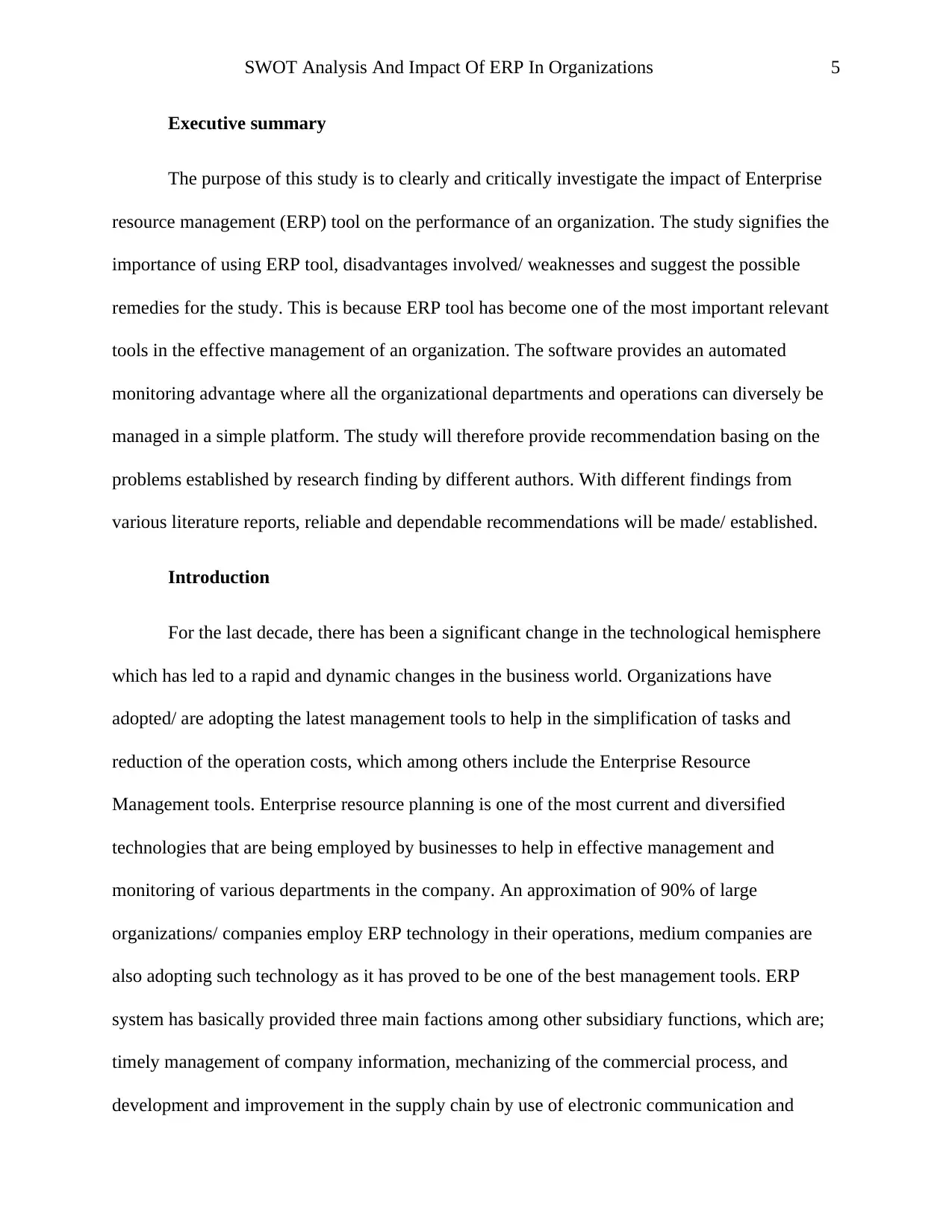
SWOT Analysis And Impact Of ERP In Organizations 5
Executive summary
The purpose of this study is to clearly and critically investigate the impact of Enterprise
resource management (ERP) tool on the performance of an organization. The study signifies the
importance of using ERP tool, disadvantages involved/ weaknesses and suggest the possible
remedies for the study. This is because ERP tool has become one of the most important relevant
tools in the effective management of an organization. The software provides an automated
monitoring advantage where all the organizational departments and operations can diversely be
managed in a simple platform. The study will therefore provide recommendation basing on the
problems established by research finding by different authors. With different findings from
various literature reports, reliable and dependable recommendations will be made/ established.
Introduction
For the last decade, there has been a significant change in the technological hemisphere
which has led to a rapid and dynamic changes in the business world. Organizations have
adopted/ are adopting the latest management tools to help in the simplification of tasks and
reduction of the operation costs, which among others include the Enterprise Resource
Management tools. Enterprise resource planning is one of the most current and diversified
technologies that are being employed by businesses to help in effective management and
monitoring of various departments in the company. An approximation of 90% of large
organizations/ companies employ ERP technology in their operations, medium companies are
also adopting such technology as it has proved to be one of the best management tools. ERP
system has basically provided three main factions among other subsidiary functions, which are;
timely management of company information, mechanizing of the commercial process, and
development and improvement in the supply chain by use of electronic communication and
Executive summary
The purpose of this study is to clearly and critically investigate the impact of Enterprise
resource management (ERP) tool on the performance of an organization. The study signifies the
importance of using ERP tool, disadvantages involved/ weaknesses and suggest the possible
remedies for the study. This is because ERP tool has become one of the most important relevant
tools in the effective management of an organization. The software provides an automated
monitoring advantage where all the organizational departments and operations can diversely be
managed in a simple platform. The study will therefore provide recommendation basing on the
problems established by research finding by different authors. With different findings from
various literature reports, reliable and dependable recommendations will be made/ established.
Introduction
For the last decade, there has been a significant change in the technological hemisphere
which has led to a rapid and dynamic changes in the business world. Organizations have
adopted/ are adopting the latest management tools to help in the simplification of tasks and
reduction of the operation costs, which among others include the Enterprise Resource
Management tools. Enterprise resource planning is one of the most current and diversified
technologies that are being employed by businesses to help in effective management and
monitoring of various departments in the company. An approximation of 90% of large
organizations/ companies employ ERP technology in their operations, medium companies are
also adopting such technology as it has proved to be one of the best management tools. ERP
system has basically provided three main factions among other subsidiary functions, which are;
timely management of company information, mechanizing of the commercial process, and
development and improvement in the supply chain by use of electronic communication and
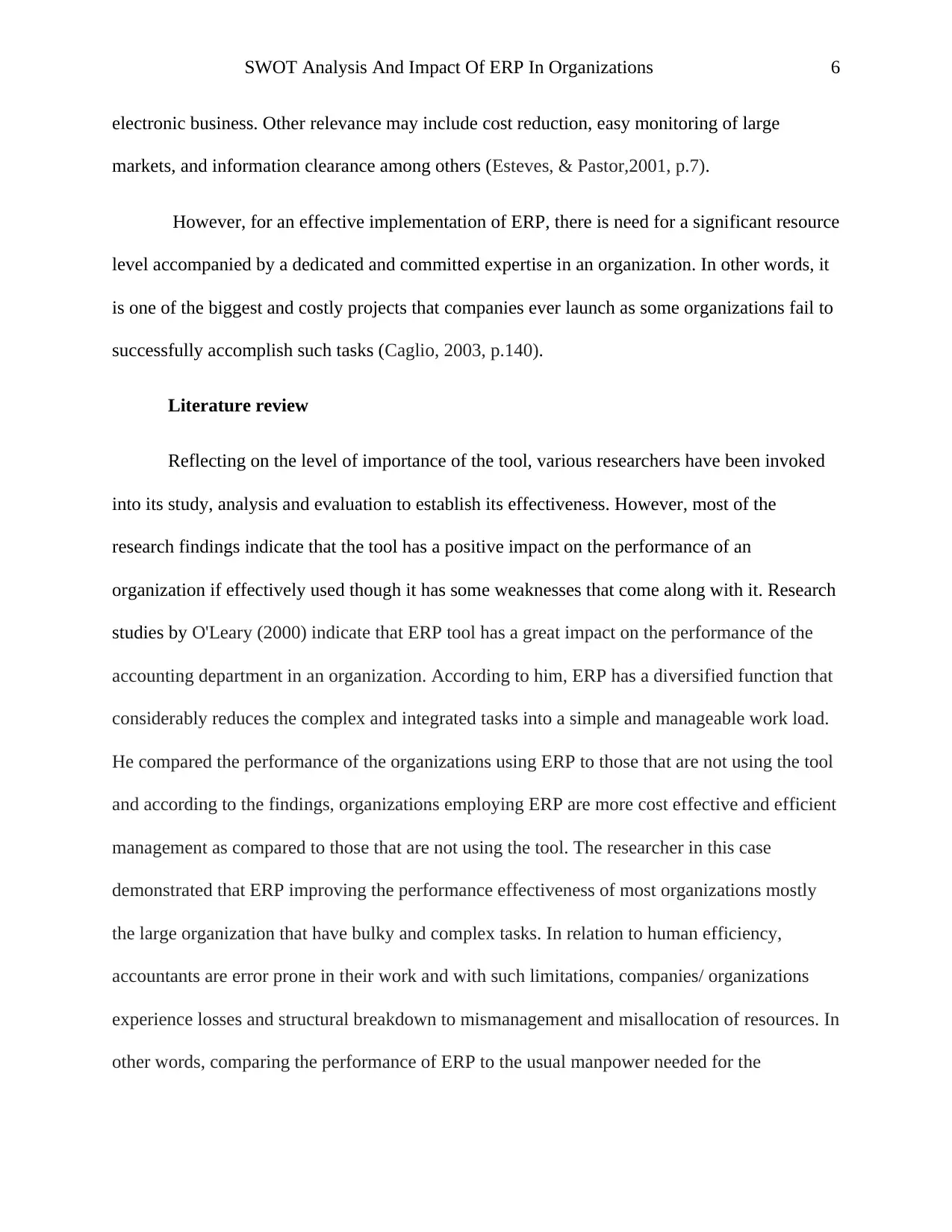
SWOT Analysis And Impact Of ERP In Organizations 6
electronic business. Other relevance may include cost reduction, easy monitoring of large
markets, and information clearance among others (Esteves, & Pastor,2001, p.7).
However, for an effective implementation of ERP, there is need for a significant resource
level accompanied by a dedicated and committed expertise in an organization. In other words, it
is one of the biggest and costly projects that companies ever launch as some organizations fail to
successfully accomplish such tasks (Caglio, 2003, p.140).
Literature review
Reflecting on the level of importance of the tool, various researchers have been invoked
into its study, analysis and evaluation to establish its effectiveness. However, most of the
research findings indicate that the tool has a positive impact on the performance of an
organization if effectively used though it has some weaknesses that come along with it. Research
studies by O'Leary (2000) indicate that ERP tool has a great impact on the performance of the
accounting department in an organization. According to him, ERP has a diversified function that
considerably reduces the complex and integrated tasks into a simple and manageable work load.
He compared the performance of the organizations using ERP to those that are not using the tool
and according to the findings, organizations employing ERP are more cost effective and efficient
management as compared to those that are not using the tool. The researcher in this case
demonstrated that ERP improving the performance effectiveness of most organizations mostly
the large organization that have bulky and complex tasks. In relation to human efficiency,
accountants are error prone in their work and with such limitations, companies/ organizations
experience losses and structural breakdown to mismanagement and misallocation of resources. In
other words, comparing the performance of ERP to the usual manpower needed for the
electronic business. Other relevance may include cost reduction, easy monitoring of large
markets, and information clearance among others (Esteves, & Pastor,2001, p.7).
However, for an effective implementation of ERP, there is need for a significant resource
level accompanied by a dedicated and committed expertise in an organization. In other words, it
is one of the biggest and costly projects that companies ever launch as some organizations fail to
successfully accomplish such tasks (Caglio, 2003, p.140).
Literature review
Reflecting on the level of importance of the tool, various researchers have been invoked
into its study, analysis and evaluation to establish its effectiveness. However, most of the
research findings indicate that the tool has a positive impact on the performance of an
organization if effectively used though it has some weaknesses that come along with it. Research
studies by O'Leary (2000) indicate that ERP tool has a great impact on the performance of the
accounting department in an organization. According to him, ERP has a diversified function that
considerably reduces the complex and integrated tasks into a simple and manageable work load.
He compared the performance of the organizations using ERP to those that are not using the tool
and according to the findings, organizations employing ERP are more cost effective and efficient
management as compared to those that are not using the tool. The researcher in this case
demonstrated that ERP improving the performance effectiveness of most organizations mostly
the large organization that have bulky and complex tasks. In relation to human efficiency,
accountants are error prone in their work and with such limitations, companies/ organizations
experience losses and structural breakdown to mismanagement and misallocation of resources. In
other words, comparing the performance of ERP to the usual manpower needed for the
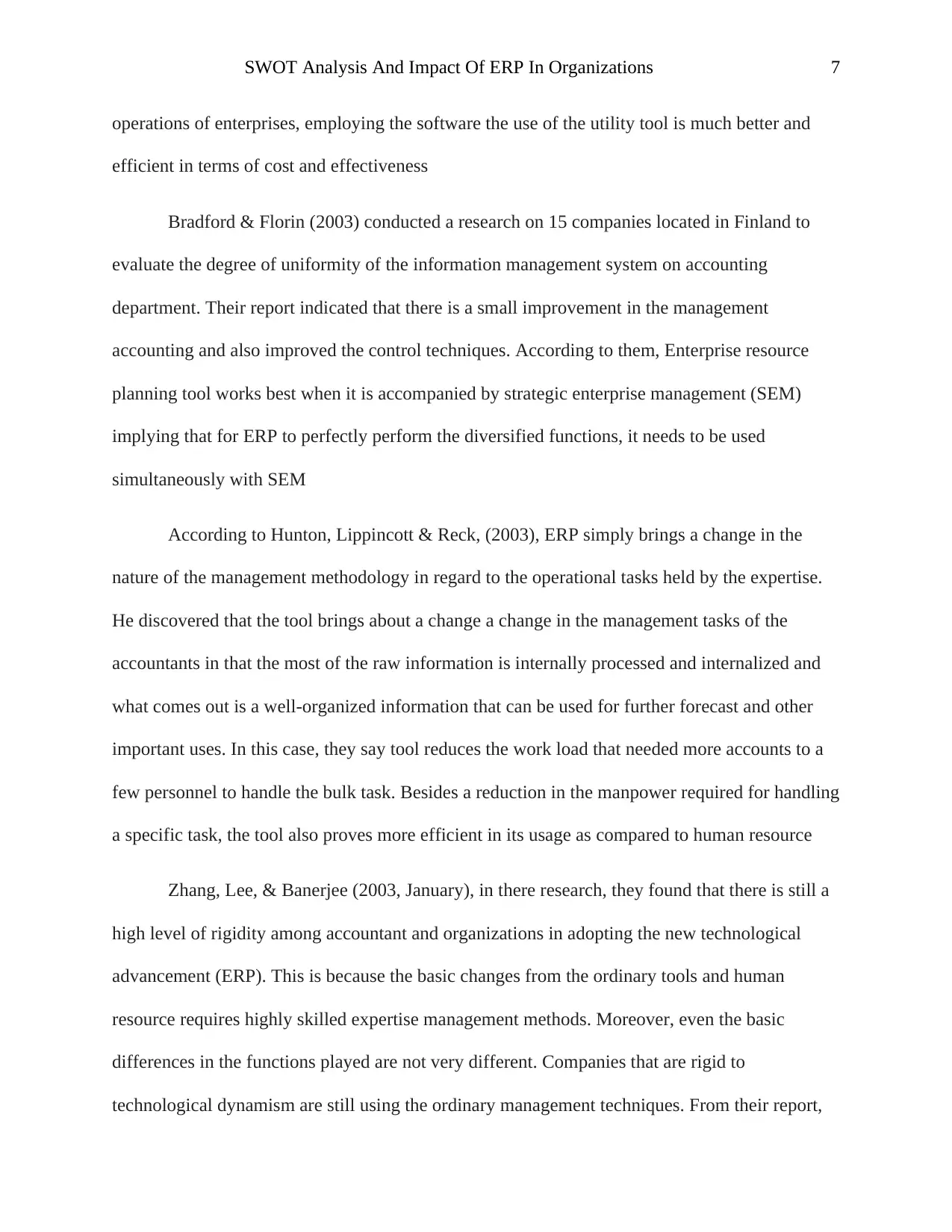
SWOT Analysis And Impact Of ERP In Organizations 7
operations of enterprises, employing the software the use of the utility tool is much better and
efficient in terms of cost and effectiveness
Bradford & Florin (2003) conducted a research on 15 companies located in Finland to
evaluate the degree of uniformity of the information management system on accounting
department. Their report indicated that there is a small improvement in the management
accounting and also improved the control techniques. According to them, Enterprise resource
planning tool works best when it is accompanied by strategic enterprise management (SEM)
implying that for ERP to perfectly perform the diversified functions, it needs to be used
simultaneously with SEM
According to Hunton, Lippincott & Reck, (2003), ERP simply brings a change in the
nature of the management methodology in regard to the operational tasks held by the expertise.
He discovered that the tool brings about a change a change in the management tasks of the
accountants in that the most of the raw information is internally processed and internalized and
what comes out is a well-organized information that can be used for further forecast and other
important uses. In this case, they say tool reduces the work load that needed more accounts to a
few personnel to handle the bulk task. Besides a reduction in the manpower required for handling
a specific task, the tool also proves more efficient in its usage as compared to human resource
Zhang, Lee, & Banerjee (2003, January), in there research, they found that there is still a
high level of rigidity among accountant and organizations in adopting the new technological
advancement (ERP). This is because the basic changes from the ordinary tools and human
resource requires highly skilled expertise management methods. Moreover, even the basic
differences in the functions played are not very different. Companies that are rigid to
technological dynamism are still using the ordinary management techniques. From their report,
operations of enterprises, employing the software the use of the utility tool is much better and
efficient in terms of cost and effectiveness
Bradford & Florin (2003) conducted a research on 15 companies located in Finland to
evaluate the degree of uniformity of the information management system on accounting
department. Their report indicated that there is a small improvement in the management
accounting and also improved the control techniques. According to them, Enterprise resource
planning tool works best when it is accompanied by strategic enterprise management (SEM)
implying that for ERP to perfectly perform the diversified functions, it needs to be used
simultaneously with SEM
According to Hunton, Lippincott & Reck, (2003), ERP simply brings a change in the
nature of the management methodology in regard to the operational tasks held by the expertise.
He discovered that the tool brings about a change a change in the management tasks of the
accountants in that the most of the raw information is internally processed and internalized and
what comes out is a well-organized information that can be used for further forecast and other
important uses. In this case, they say tool reduces the work load that needed more accounts to a
few personnel to handle the bulk task. Besides a reduction in the manpower required for handling
a specific task, the tool also proves more efficient in its usage as compared to human resource
Zhang, Lee, & Banerjee (2003, January), in there research, they found that there is still a
high level of rigidity among accountant and organizations in adopting the new technological
advancement (ERP). This is because the basic changes from the ordinary tools and human
resource requires highly skilled expertise management methods. Moreover, even the basic
differences in the functions played are not very different. Companies that are rigid to
technological dynamism are still using the ordinary management techniques. From their report,
Paraphrase This Document
Need a fresh take? Get an instant paraphrase of this document with our AI Paraphraser
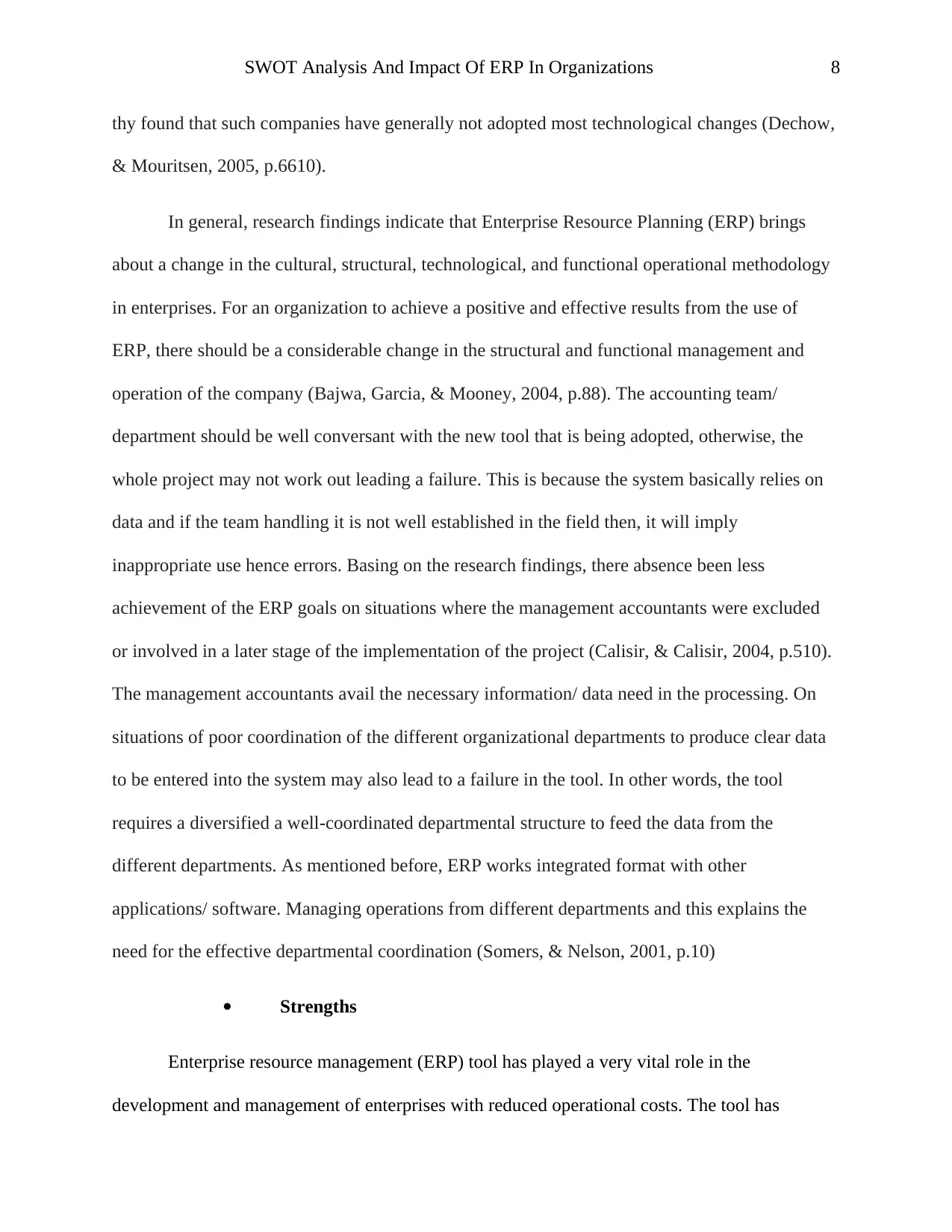
SWOT Analysis And Impact Of ERP In Organizations 8
thy found that such companies have generally not adopted most technological changes (Dechow,
& Mouritsen, 2005, p.6610).
In general, research findings indicate that Enterprise Resource Planning (ERP) brings
about a change in the cultural, structural, technological, and functional operational methodology
in enterprises. For an organization to achieve a positive and effective results from the use of
ERP, there should be a considerable change in the structural and functional management and
operation of the company (Bajwa, Garcia, & Mooney, 2004, p.88). The accounting team/
department should be well conversant with the new tool that is being adopted, otherwise, the
whole project may not work out leading a failure. This is because the system basically relies on
data and if the team handling it is not well established in the field then, it will imply
inappropriate use hence errors. Basing on the research findings, there absence been less
achievement of the ERP goals on situations where the management accountants were excluded
or involved in a later stage of the implementation of the project (Calisir, & Calisir, 2004, p.510).
The management accountants avail the necessary information/ data need in the processing. On
situations of poor coordination of the different organizational departments to produce clear data
to be entered into the system may also lead to a failure in the tool. In other words, the tool
requires a diversified a well-coordinated departmental structure to feed the data from the
different departments. As mentioned before, ERP works integrated format with other
applications/ software. Managing operations from different departments and this explains the
need for the effective departmental coordination (Somers, & Nelson, 2001, p.10)
Strengths
Enterprise resource management (ERP) tool has played a very vital role in the
development and management of enterprises with reduced operational costs. The tool has
thy found that such companies have generally not adopted most technological changes (Dechow,
& Mouritsen, 2005, p.6610).
In general, research findings indicate that Enterprise Resource Planning (ERP) brings
about a change in the cultural, structural, technological, and functional operational methodology
in enterprises. For an organization to achieve a positive and effective results from the use of
ERP, there should be a considerable change in the structural and functional management and
operation of the company (Bajwa, Garcia, & Mooney, 2004, p.88). The accounting team/
department should be well conversant with the new tool that is being adopted, otherwise, the
whole project may not work out leading a failure. This is because the system basically relies on
data and if the team handling it is not well established in the field then, it will imply
inappropriate use hence errors. Basing on the research findings, there absence been less
achievement of the ERP goals on situations where the management accountants were excluded
or involved in a later stage of the implementation of the project (Calisir, & Calisir, 2004, p.510).
The management accountants avail the necessary information/ data need in the processing. On
situations of poor coordination of the different organizational departments to produce clear data
to be entered into the system may also lead to a failure in the tool. In other words, the tool
requires a diversified a well-coordinated departmental structure to feed the data from the
different departments. As mentioned before, ERP works integrated format with other
applications/ software. Managing operations from different departments and this explains the
need for the effective departmental coordination (Somers, & Nelson, 2001, p.10)
Strengths
Enterprise resource management (ERP) tool has played a very vital role in the
development and management of enterprises with reduced operational costs. The tool has
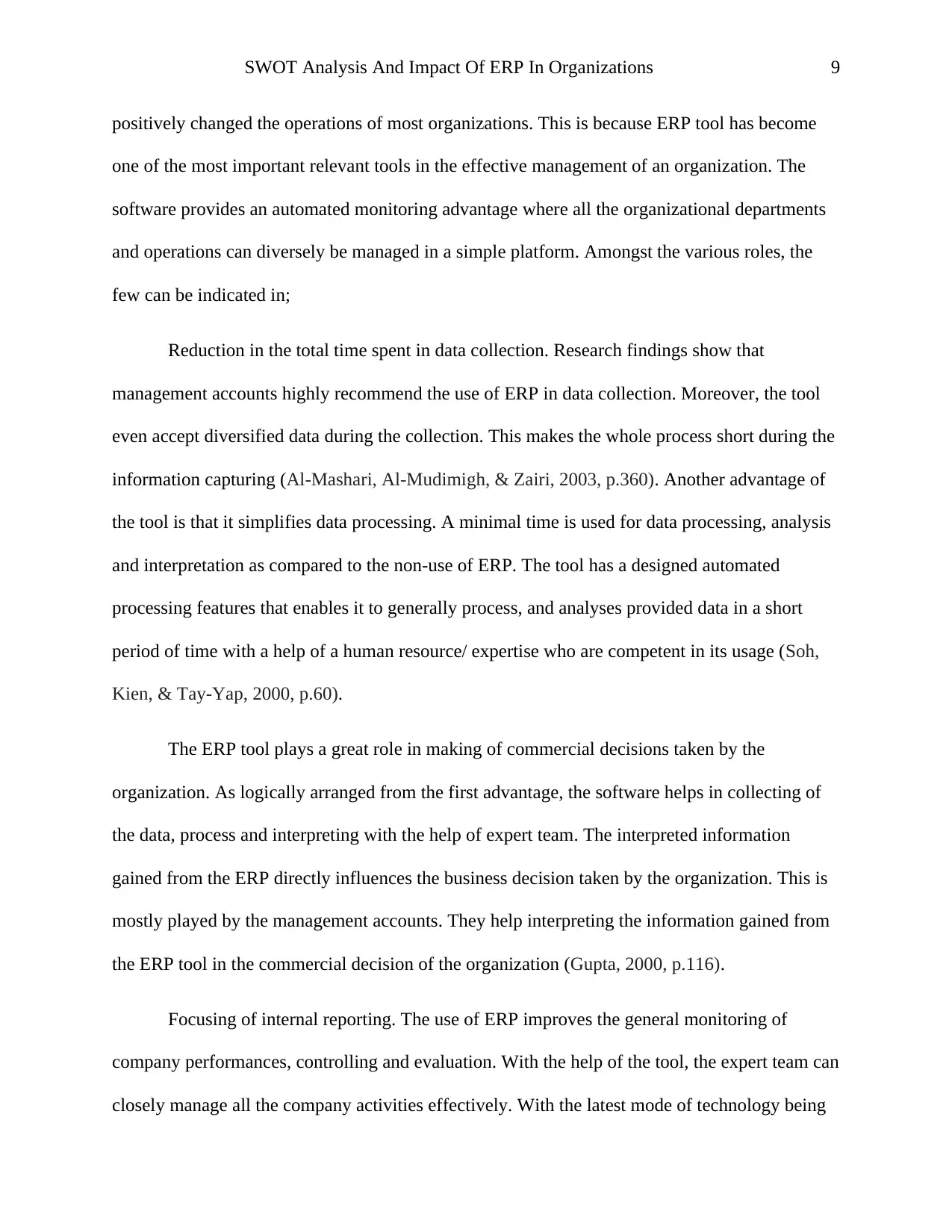
SWOT Analysis And Impact Of ERP In Organizations 9
positively changed the operations of most organizations. This is because ERP tool has become
one of the most important relevant tools in the effective management of an organization. The
software provides an automated monitoring advantage where all the organizational departments
and operations can diversely be managed in a simple platform. Amongst the various roles, the
few can be indicated in;
Reduction in the total time spent in data collection. Research findings show that
management accounts highly recommend the use of ERP in data collection. Moreover, the tool
even accept diversified data during the collection. This makes the whole process short during the
information capturing (Al-Mashari, Al-Mudimigh, & Zairi, 2003, p.360). Another advantage of
the tool is that it simplifies data processing. A minimal time is used for data processing, analysis
and interpretation as compared to the non-use of ERP. The tool has a designed automated
processing features that enables it to generally process, and analyses provided data in a short
period of time with a help of a human resource/ expertise who are competent in its usage (Soh,
Kien, & Tay-Yap, 2000, p.60).
The ERP tool plays a great role in making of commercial decisions taken by the
organization. As logically arranged from the first advantage, the software helps in collecting of
the data, process and interpreting with the help of expert team. The interpreted information
gained from the ERP directly influences the business decision taken by the organization. This is
mostly played by the management accounts. They help interpreting the information gained from
the ERP tool in the commercial decision of the organization (Gupta, 2000, p.116).
Focusing of internal reporting. The use of ERP improves the general monitoring of
company performances, controlling and evaluation. With the help of the tool, the expert team can
closely manage all the company activities effectively. With the latest mode of technology being
positively changed the operations of most organizations. This is because ERP tool has become
one of the most important relevant tools in the effective management of an organization. The
software provides an automated monitoring advantage where all the organizational departments
and operations can diversely be managed in a simple platform. Amongst the various roles, the
few can be indicated in;
Reduction in the total time spent in data collection. Research findings show that
management accounts highly recommend the use of ERP in data collection. Moreover, the tool
even accept diversified data during the collection. This makes the whole process short during the
information capturing (Al-Mashari, Al-Mudimigh, & Zairi, 2003, p.360). Another advantage of
the tool is that it simplifies data processing. A minimal time is used for data processing, analysis
and interpretation as compared to the non-use of ERP. The tool has a designed automated
processing features that enables it to generally process, and analyses provided data in a short
period of time with a help of a human resource/ expertise who are competent in its usage (Soh,
Kien, & Tay-Yap, 2000, p.60).
The ERP tool plays a great role in making of commercial decisions taken by the
organization. As logically arranged from the first advantage, the software helps in collecting of
the data, process and interpreting with the help of expert team. The interpreted information
gained from the ERP directly influences the business decision taken by the organization. This is
mostly played by the management accounts. They help interpreting the information gained from
the ERP tool in the commercial decision of the organization (Gupta, 2000, p.116).
Focusing of internal reporting. The use of ERP improves the general monitoring of
company performances, controlling and evaluation. With the help of the tool, the expert team can
closely manage all the company activities effectively. With the latest mode of technology being
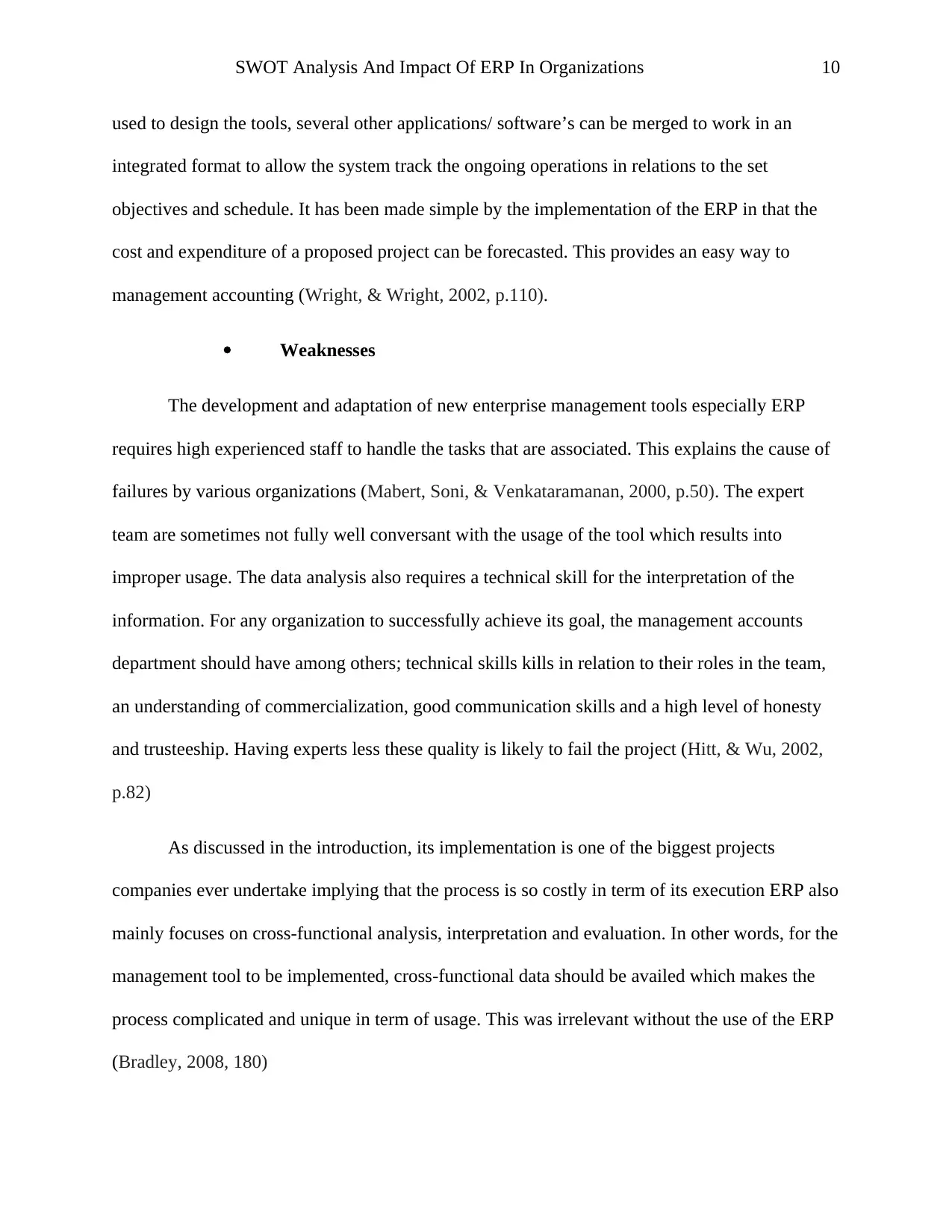
SWOT Analysis And Impact Of ERP In Organizations 10
used to design the tools, several other applications/ software’s can be merged to work in an
integrated format to allow the system track the ongoing operations in relations to the set
objectives and schedule. It has been made simple by the implementation of the ERP in that the
cost and expenditure of a proposed project can be forecasted. This provides an easy way to
management accounting (Wright, & Wright, 2002, p.110).
Weaknesses
The development and adaptation of new enterprise management tools especially ERP
requires high experienced staff to handle the tasks that are associated. This explains the cause of
failures by various organizations (Mabert, Soni, & Venkataramanan, 2000, p.50). The expert
team are sometimes not fully well conversant with the usage of the tool which results into
improper usage. The data analysis also requires a technical skill for the interpretation of the
information. For any organization to successfully achieve its goal, the management accounts
department should have among others; technical skills kills in relation to their roles in the team,
an understanding of commercialization, good communication skills and a high level of honesty
and trusteeship. Having experts less these quality is likely to fail the project (Hitt, & Wu, 2002,
p.82)
As discussed in the introduction, its implementation is one of the biggest projects
companies ever undertake implying that the process is so costly in term of its execution ERP also
mainly focuses on cross-functional analysis, interpretation and evaluation. In other words, for the
management tool to be implemented, cross-functional data should be availed which makes the
process complicated and unique in term of usage. This was irrelevant without the use of the ERP
(Bradley, 2008, 180)
used to design the tools, several other applications/ software’s can be merged to work in an
integrated format to allow the system track the ongoing operations in relations to the set
objectives and schedule. It has been made simple by the implementation of the ERP in that the
cost and expenditure of a proposed project can be forecasted. This provides an easy way to
management accounting (Wright, & Wright, 2002, p.110).
Weaknesses
The development and adaptation of new enterprise management tools especially ERP
requires high experienced staff to handle the tasks that are associated. This explains the cause of
failures by various organizations (Mabert, Soni, & Venkataramanan, 2000, p.50). The expert
team are sometimes not fully well conversant with the usage of the tool which results into
improper usage. The data analysis also requires a technical skill for the interpretation of the
information. For any organization to successfully achieve its goal, the management accounts
department should have among others; technical skills kills in relation to their roles in the team,
an understanding of commercialization, good communication skills and a high level of honesty
and trusteeship. Having experts less these quality is likely to fail the project (Hitt, & Wu, 2002,
p.82)
As discussed in the introduction, its implementation is one of the biggest projects
companies ever undertake implying that the process is so costly in term of its execution ERP also
mainly focuses on cross-functional analysis, interpretation and evaluation. In other words, for the
management tool to be implemented, cross-functional data should be availed which makes the
process complicated and unique in term of usage. This was irrelevant without the use of the ERP
(Bradley, 2008, 180)
Secure Best Marks with AI Grader
Need help grading? Try our AI Grader for instant feedback on your assignments.
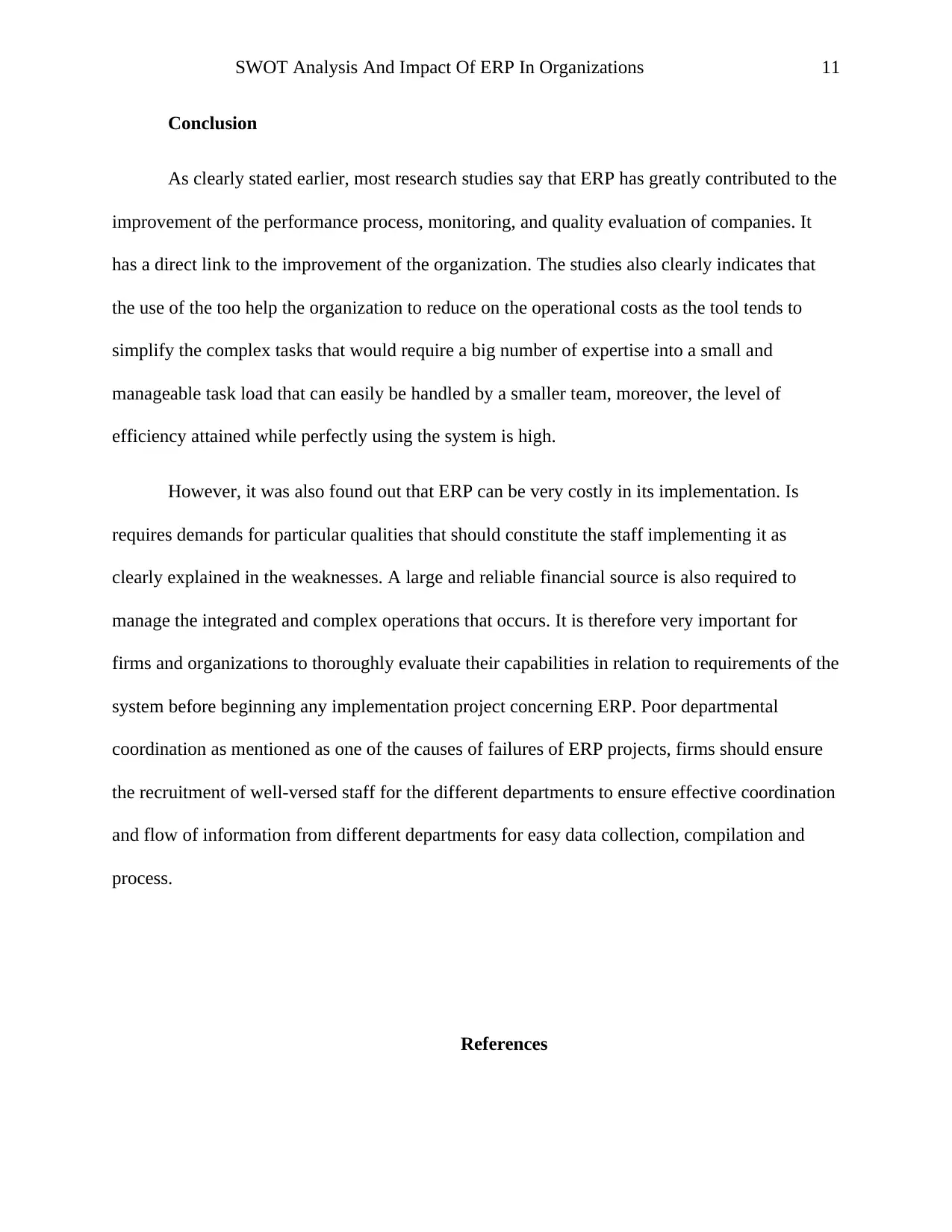
SWOT Analysis And Impact Of ERP In Organizations 11
Conclusion
As clearly stated earlier, most research studies say that ERP has greatly contributed to the
improvement of the performance process, monitoring, and quality evaluation of companies. It
has a direct link to the improvement of the organization. The studies also clearly indicates that
the use of the too help the organization to reduce on the operational costs as the tool tends to
simplify the complex tasks that would require a big number of expertise into a small and
manageable task load that can easily be handled by a smaller team, moreover, the level of
efficiency attained while perfectly using the system is high.
However, it was also found out that ERP can be very costly in its implementation. Is
requires demands for particular qualities that should constitute the staff implementing it as
clearly explained in the weaknesses. A large and reliable financial source is also required to
manage the integrated and complex operations that occurs. It is therefore very important for
firms and organizations to thoroughly evaluate their capabilities in relation to requirements of the
system before beginning any implementation project concerning ERP. Poor departmental
coordination as mentioned as one of the causes of failures of ERP projects, firms should ensure
the recruitment of well-versed staff for the different departments to ensure effective coordination
and flow of information from different departments for easy data collection, compilation and
process.
References
Conclusion
As clearly stated earlier, most research studies say that ERP has greatly contributed to the
improvement of the performance process, monitoring, and quality evaluation of companies. It
has a direct link to the improvement of the organization. The studies also clearly indicates that
the use of the too help the organization to reduce on the operational costs as the tool tends to
simplify the complex tasks that would require a big number of expertise into a small and
manageable task load that can easily be handled by a smaller team, moreover, the level of
efficiency attained while perfectly using the system is high.
However, it was also found out that ERP can be very costly in its implementation. Is
requires demands for particular qualities that should constitute the staff implementing it as
clearly explained in the weaknesses. A large and reliable financial source is also required to
manage the integrated and complex operations that occurs. It is therefore very important for
firms and organizations to thoroughly evaluate their capabilities in relation to requirements of the
system before beginning any implementation project concerning ERP. Poor departmental
coordination as mentioned as one of the causes of failures of ERP projects, firms should ensure
the recruitment of well-versed staff for the different departments to ensure effective coordination
and flow of information from different departments for easy data collection, compilation and
process.
References
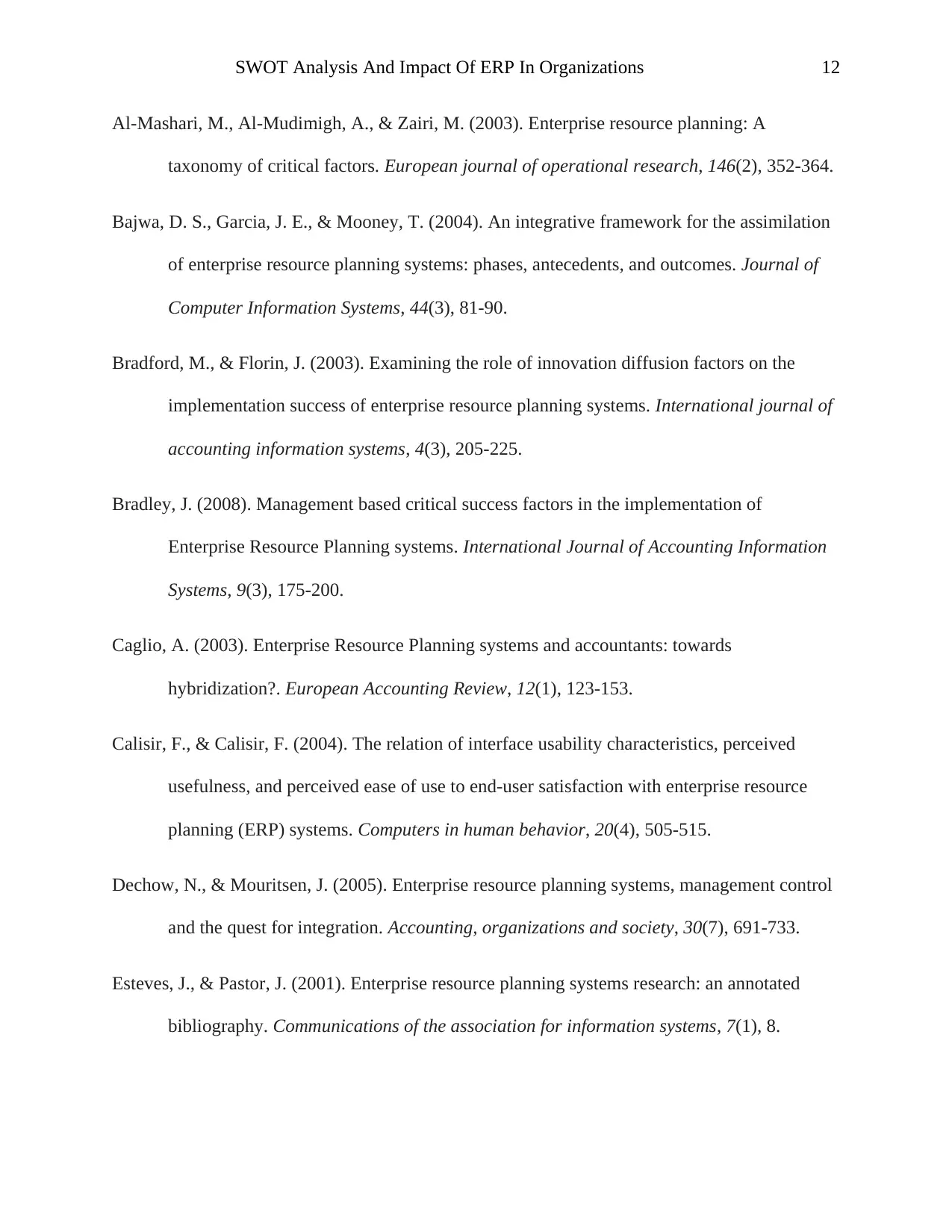
SWOT Analysis And Impact Of ERP In Organizations 12
Al-Mashari, M., Al-Mudimigh, A., & Zairi, M. (2003). Enterprise resource planning: A
taxonomy of critical factors. European journal of operational research, 146(2), 352-364.
Bajwa, D. S., Garcia, J. E., & Mooney, T. (2004). An integrative framework for the assimilation
of enterprise resource planning systems: phases, antecedents, and outcomes. Journal of
Computer Information Systems, 44(3), 81-90.
Bradford, M., & Florin, J. (2003). Examining the role of innovation diffusion factors on the
implementation success of enterprise resource planning systems. International journal of
accounting information systems, 4(3), 205-225.
Bradley, J. (2008). Management based critical success factors in the implementation of
Enterprise Resource Planning systems. International Journal of Accounting Information
Systems, 9(3), 175-200.
Caglio, A. (2003). Enterprise Resource Planning systems and accountants: towards
hybridization?. European Accounting Review, 12(1), 123-153.
Calisir, F., & Calisir, F. (2004). The relation of interface usability characteristics, perceived
usefulness, and perceived ease of use to end-user satisfaction with enterprise resource
planning (ERP) systems. Computers in human behavior, 20(4), 505-515.
Dechow, N., & Mouritsen, J. (2005). Enterprise resource planning systems, management control
and the quest for integration. Accounting, organizations and society, 30(7), 691-733.
Esteves, J., & Pastor, J. (2001). Enterprise resource planning systems research: an annotated
bibliography. Communications of the association for information systems, 7(1), 8.
Al-Mashari, M., Al-Mudimigh, A., & Zairi, M. (2003). Enterprise resource planning: A
taxonomy of critical factors. European journal of operational research, 146(2), 352-364.
Bajwa, D. S., Garcia, J. E., & Mooney, T. (2004). An integrative framework for the assimilation
of enterprise resource planning systems: phases, antecedents, and outcomes. Journal of
Computer Information Systems, 44(3), 81-90.
Bradford, M., & Florin, J. (2003). Examining the role of innovation diffusion factors on the
implementation success of enterprise resource planning systems. International journal of
accounting information systems, 4(3), 205-225.
Bradley, J. (2008). Management based critical success factors in the implementation of
Enterprise Resource Planning systems. International Journal of Accounting Information
Systems, 9(3), 175-200.
Caglio, A. (2003). Enterprise Resource Planning systems and accountants: towards
hybridization?. European Accounting Review, 12(1), 123-153.
Calisir, F., & Calisir, F. (2004). The relation of interface usability characteristics, perceived
usefulness, and perceived ease of use to end-user satisfaction with enterprise resource
planning (ERP) systems. Computers in human behavior, 20(4), 505-515.
Dechow, N., & Mouritsen, J. (2005). Enterprise resource planning systems, management control
and the quest for integration. Accounting, organizations and society, 30(7), 691-733.
Esteves, J., & Pastor, J. (2001). Enterprise resource planning systems research: an annotated
bibliography. Communications of the association for information systems, 7(1), 8.
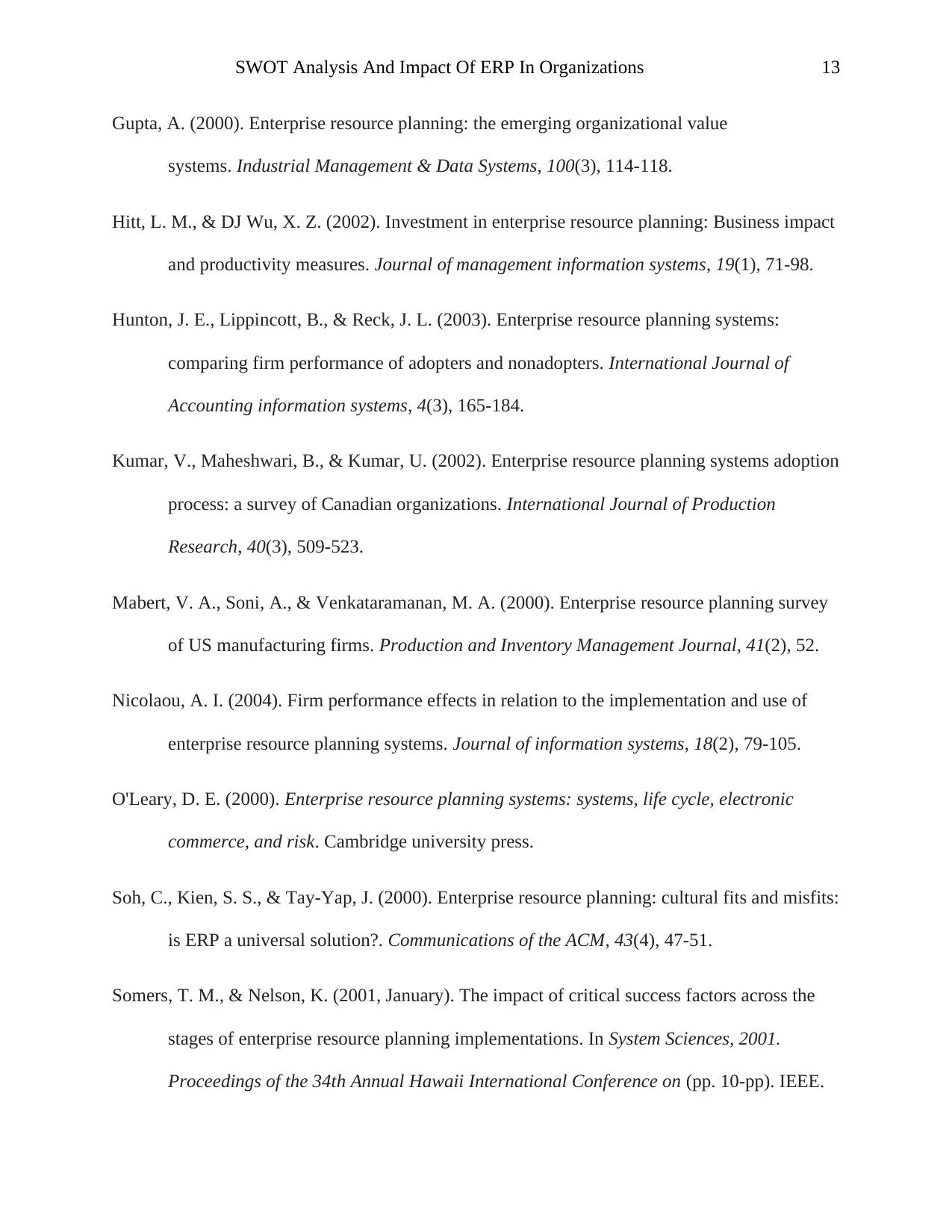
SWOT Analysis And Impact Of ERP In Organizations 13
Gupta, A. (2000). Enterprise resource planning: the emerging organizational value
systems. Industrial Management & Data Systems, 100(3), 114-118.
Hitt, L. M., & DJ Wu, X. Z. (2002). Investment in enterprise resource planning: Business impact
and productivity measures. Journal of management information systems, 19(1), 71-98.
Hunton, J. E., Lippincott, B., & Reck, J. L. (2003). Enterprise resource planning systems:
comparing firm performance of adopters and nonadopters. International Journal of
Accounting information systems, 4(3), 165-184.
Kumar, V., Maheshwari, B., & Kumar, U. (2002). Enterprise resource planning systems adoption
process: a survey of Canadian organizations. International Journal of Production
Research, 40(3), 509-523.
Mabert, V. A., Soni, A., & Venkataramanan, M. A. (2000). Enterprise resource planning survey
of US manufacturing firms. Production and Inventory Management Journal, 41(2), 52.
Nicolaou, A. I. (2004). Firm performance effects in relation to the implementation and use of
enterprise resource planning systems. Journal of information systems, 18(2), 79-105.
O'Leary, D. E. (2000). Enterprise resource planning systems: systems, life cycle, electronic
commerce, and risk. Cambridge university press.
Soh, C., Kien, S. S., & Tay-Yap, J. (2000). Enterprise resource planning: cultural fits and misfits:
is ERP a universal solution?. Communications of the ACM, 43(4), 47-51.
Somers, T. M., & Nelson, K. (2001, January). The impact of critical success factors across the
stages of enterprise resource planning implementations. In System Sciences, 2001.
Proceedings of the 34th Annual Hawaii International Conference on (pp. 10-pp). IEEE.
Gupta, A. (2000). Enterprise resource planning: the emerging organizational value
systems. Industrial Management & Data Systems, 100(3), 114-118.
Hitt, L. M., & DJ Wu, X. Z. (2002). Investment in enterprise resource planning: Business impact
and productivity measures. Journal of management information systems, 19(1), 71-98.
Hunton, J. E., Lippincott, B., & Reck, J. L. (2003). Enterprise resource planning systems:
comparing firm performance of adopters and nonadopters. International Journal of
Accounting information systems, 4(3), 165-184.
Kumar, V., Maheshwari, B., & Kumar, U. (2002). Enterprise resource planning systems adoption
process: a survey of Canadian organizations. International Journal of Production
Research, 40(3), 509-523.
Mabert, V. A., Soni, A., & Venkataramanan, M. A. (2000). Enterprise resource planning survey
of US manufacturing firms. Production and Inventory Management Journal, 41(2), 52.
Nicolaou, A. I. (2004). Firm performance effects in relation to the implementation and use of
enterprise resource planning systems. Journal of information systems, 18(2), 79-105.
O'Leary, D. E. (2000). Enterprise resource planning systems: systems, life cycle, electronic
commerce, and risk. Cambridge university press.
Soh, C., Kien, S. S., & Tay-Yap, J. (2000). Enterprise resource planning: cultural fits and misfits:
is ERP a universal solution?. Communications of the ACM, 43(4), 47-51.
Somers, T. M., & Nelson, K. (2001, January). The impact of critical success factors across the
stages of enterprise resource planning implementations. In System Sciences, 2001.
Proceedings of the 34th Annual Hawaii International Conference on (pp. 10-pp). IEEE.
Paraphrase This Document
Need a fresh take? Get an instant paraphrase of this document with our AI Paraphraser
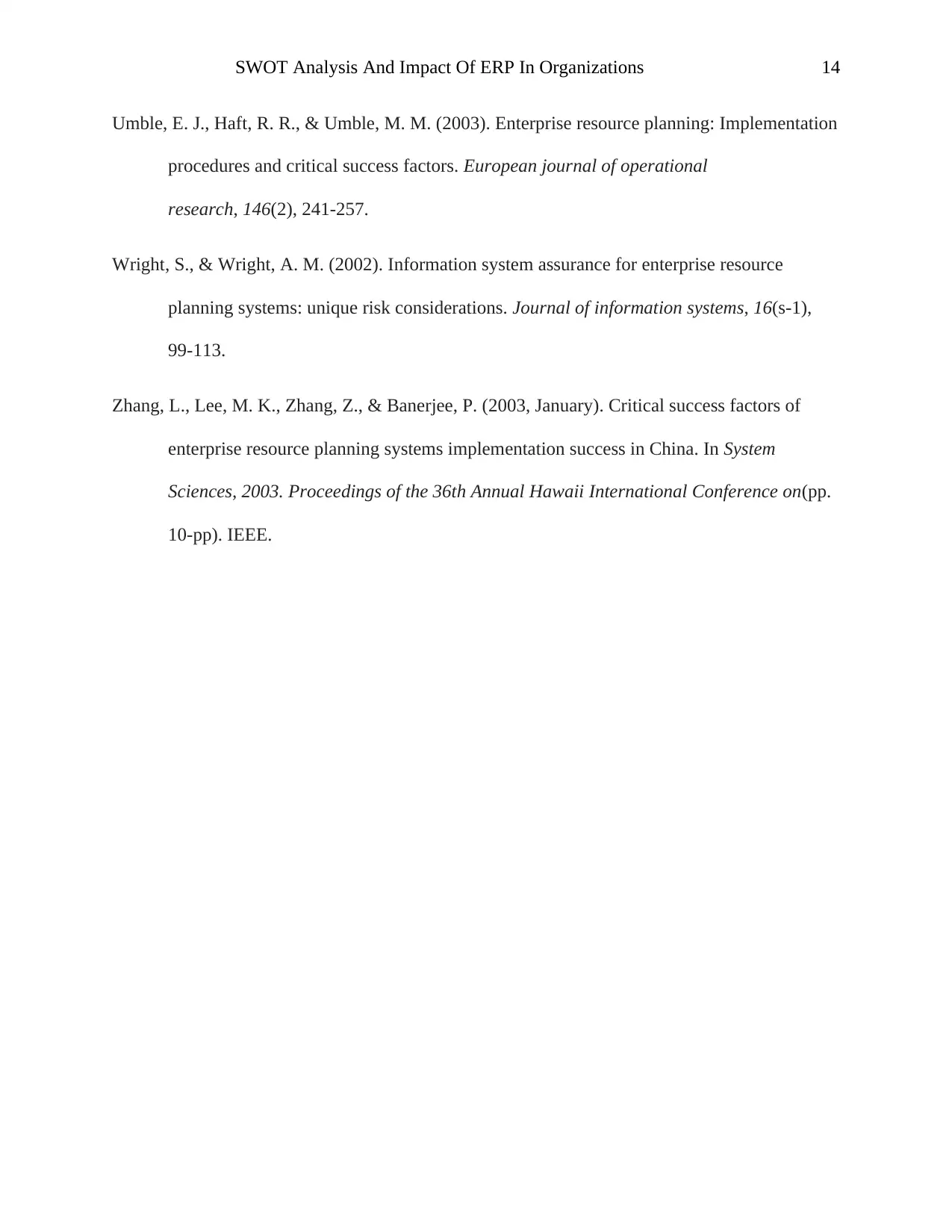
SWOT Analysis And Impact Of ERP In Organizations 14
Umble, E. J., Haft, R. R., & Umble, M. M. (2003). Enterprise resource planning: Implementation
procedures and critical success factors. European journal of operational
research, 146(2), 241-257.
Wright, S., & Wright, A. M. (2002). Information system assurance for enterprise resource
planning systems: unique risk considerations. Journal of information systems, 16(s-1),
99-113.
Zhang, L., Lee, M. K., Zhang, Z., & Banerjee, P. (2003, January). Critical success factors of
enterprise resource planning systems implementation success in China. In System
Sciences, 2003. Proceedings of the 36th Annual Hawaii International Conference on(pp.
10-pp). IEEE.
Umble, E. J., Haft, R. R., & Umble, M. M. (2003). Enterprise resource planning: Implementation
procedures and critical success factors. European journal of operational
research, 146(2), 241-257.
Wright, S., & Wright, A. M. (2002). Information system assurance for enterprise resource
planning systems: unique risk considerations. Journal of information systems, 16(s-1),
99-113.
Zhang, L., Lee, M. K., Zhang, Z., & Banerjee, P. (2003, January). Critical success factors of
enterprise resource planning systems implementation success in China. In System
Sciences, 2003. Proceedings of the 36th Annual Hawaii International Conference on(pp.
10-pp). IEEE.
1 out of 14
Your All-in-One AI-Powered Toolkit for Academic Success.
+13062052269
info@desklib.com
Available 24*7 on WhatsApp / Email
![[object Object]](/_next/static/media/star-bottom.7253800d.svg)
Unlock your academic potential
© 2024 | Zucol Services PVT LTD | All rights reserved.